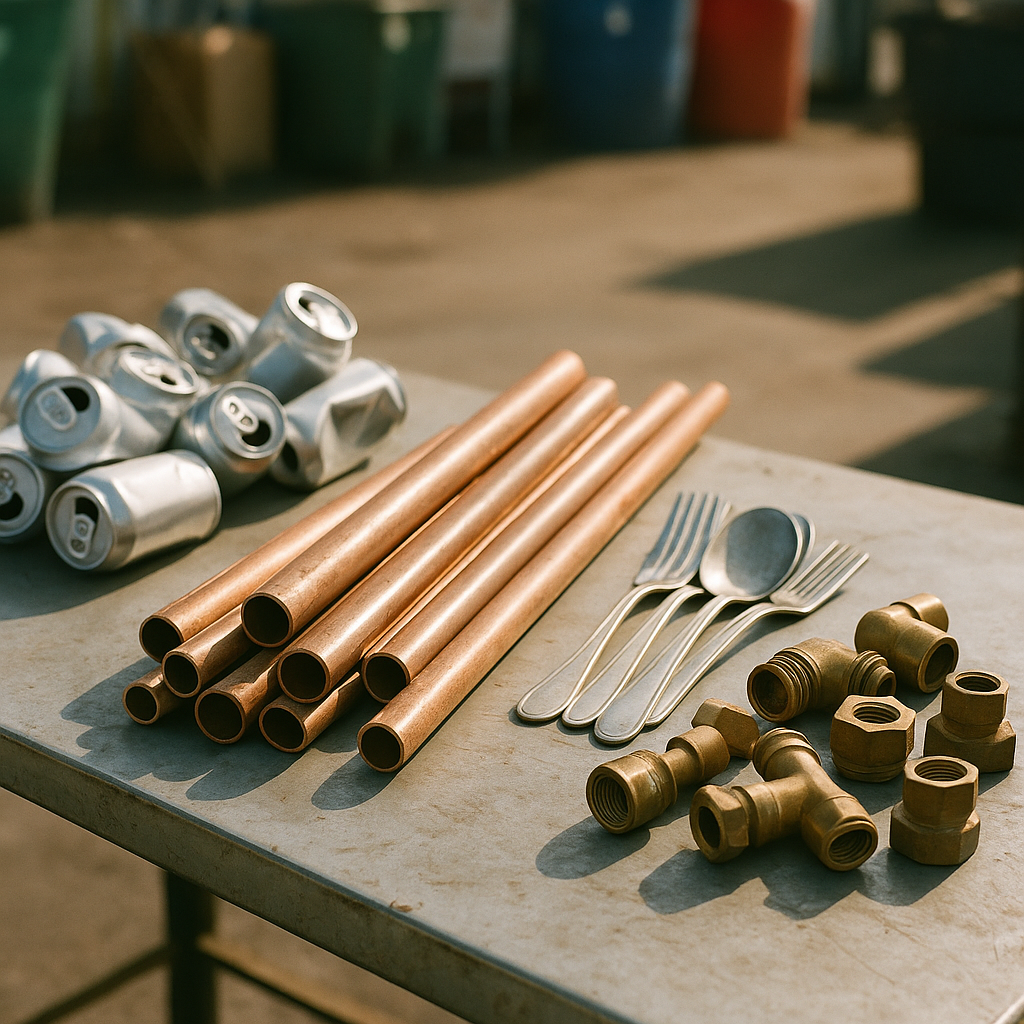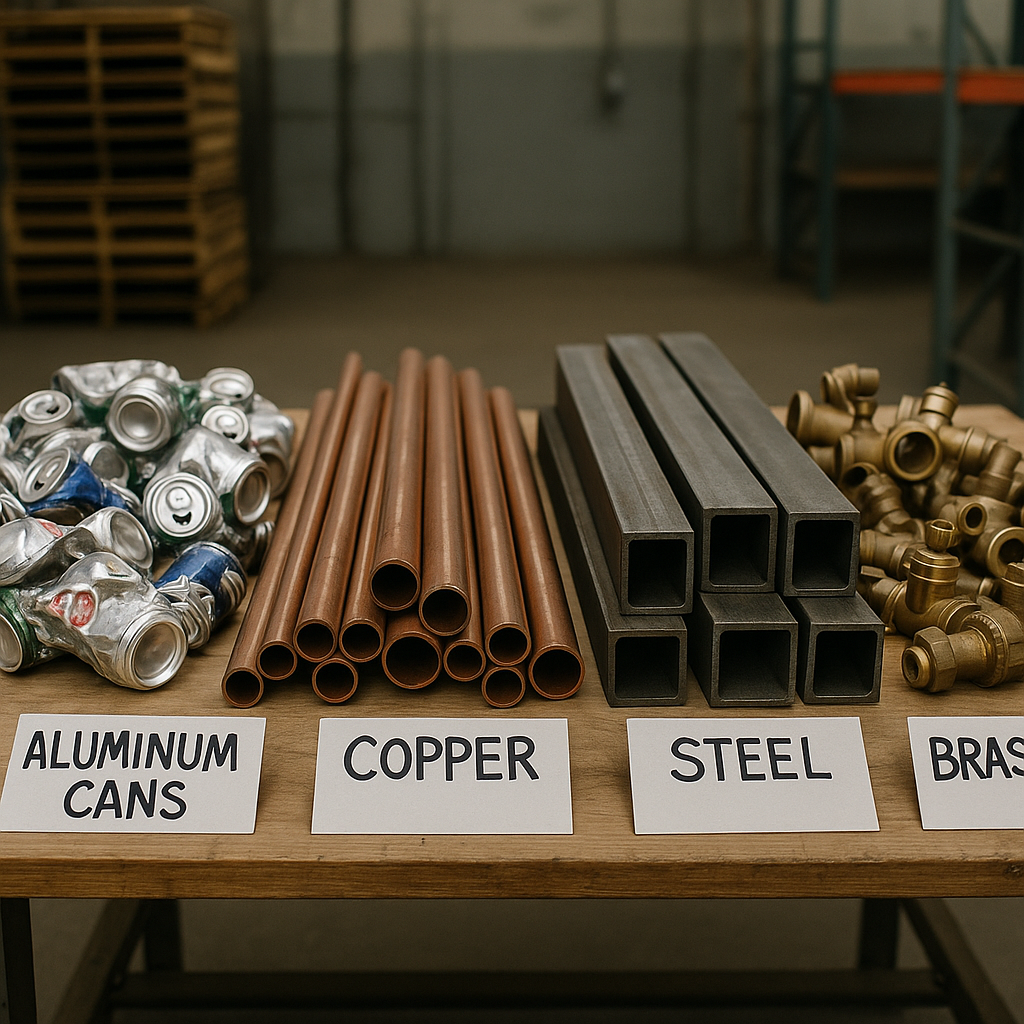5901 Botham Jean Blvd, Dallas, TX 75215
Metal Scrap Collection Importance: Benefits, Process, and Environmental Impact
September 27, 2025Each year, Americans recycle over 130 million tons of scrap metal, preventing 29 million tons of carbon dioxide emissions. This achievement is driven by a straightforward yet impactful practice: metal scrap collection.
Metal scrap collection involves systematically gathering discarded metal items from various sources for recycling. This process includes collecting items like aluminum cans, copper wiring, steel beams, and old appliances. These materials are then sorted, processed, and transformed into valuable resources instead of ending up in landfills.
The importance of metal scrap collection goes beyond mere waste management. Recycling metals, as opposed to mining virgin ore, conserves finite natural resources. For instance, recycling aluminum saves 95% of the energy needed for new production, while steel recycling preserves 2,500 pounds of iron ore, 1,400 pounds of coal, and 120 pounds of limestone per ton recycled.
How Do You Start Collecting Metal Scrap?

Starting a metal scrap collection requires organization and a basic understanding of metal types. Set up dedicated bins in an accessible area of your home or business. For beginners, plastic tubs, buckets, or sturdy cardboard boxes work well until you determine your collection volume.
Set Up Your Sorting System
Create separate containers for different metal types. At a minimum, you’ll need bins for ferrous metals (containing iron) and non-ferrous metals (without iron). Non-ferrous metals like copper, aluminum, and brass typically offer higher returns at recycling facilities.
For more efficient sorting, consider additional containers for common metals such as:
- Aluminum (cans, siding, gutters)
- Copper (wiring, pipes, roofing materials)
- Brass (fixtures, decorative items)
- Steel (structural materials, appliance shells)
- Stainless steel (kitchen equipment, sinks)
Use the Magnet Test
The magnet test is a simple tool for identifying metals. Any magnet will work, even one from your refrigerator. Hold it against the metal item:
- If the magnet sticks: You have a ferrous metal like steel or iron.
- If the magnet doesn’t stick: You have a non-ferrous metal like copper, aluminum, or brass.
This quick test helps you sort metals into their proper categories without specialized equipment. Non-ferrous metals typically yield higher values at scrap yards, so correctly identifying them is worthwhile.
Remove Contaminants
Clean metals are more valuable. Remove non-metal attachments like plastic, rubber, or wood whenever possible. For copper wire, stripping the insulation can increase its value by 30-50%. Wipe down greasy components, as excessive oil can reduce pricing or even lead to rejection at some facilities.
For Businesses: Conduct a Scrap Metal Audit
Businesses should consider a scrap metal audit to identify recycling opportunities. Walk through your operations and look for:
- Manufacturing waste and off-cuts
- Outdated equipment or fixtures
- Packaging materials (strapping, wire)
- Maintenance waste (replaced parts, old fixtures)
Document the types of metal waste you generate, their approximate volumes, and how frequently they accumulate. This information helps you design an appropriate collection system and potentially negotiate better terms with recycling facilities.
| Metal Type | Appearance/Color | Identification Method | Common Uses |
|---|---|---|---|
| Copper | Reddish-brown, develops a green patina over time | Non-magnetic, easily filed and flakes off gently | Electrical wiring, plumbing, electronics |
| Brass | Yellow-brown or golden | Non-magnetic, often mistaken for gold | Musical instruments, plumbing fixtures, decorative items |
| Aluminum | Silvery-gray with a matte finish | Non-magnetic, lightweight | Beverage cans, window frames, aerospace components |
| Steel/Iron | Gray, develops flaky rust | Magnetic, rust indicates ferrous content | Construction materials, automotive parts |
| Stainless Steel | Bright, reflective | May be non-magnetic depending on alloy type | Kitchenware, medical instruments, architecture |
Find a Reputable Recycling Facility
Research local scrap yards and recycling centers before your first trip. Call ahead to verify:
- What materials they accept
- Current pricing for different metals
- Required preparation (size limits, cleanliness standards)
- Documentation needed (ID requirements vary by location)
- Transportation assistance for large quantities
Building a relationship with a reliable recycler often leads to better service and potentially better rates over time. Some facilities offer container drop-off services for businesses with regular volumes, making collection even more convenient.
By implementing these basic steps, you’ll have a functional scrap metal collection system that helps divert valuable resources from landfills while potentially generating extra income. Start small, refine your process as you learn, and watch your collection grow.
Where Can You Find Metal Scrap to Collect?


Finding quality scrap metal doesn’t require special connections or equipment. Start your search at home and expand to various community locations. Identifying potential sources and approaching them effectively is key.
Start With Your Home
Your household likely has unused metal items that can be converted into cash. Check your garage, basement, attic, and storage areas for metal items that are no longer needed.
Common household metal items worth collecting include:
- Old appliances (toasters, microwaves, mixers)
- Electrical wiring from renovation projects
- Plumbing fixtures and copper pipe scraps
- Aluminum siding or gutters
- Metal shelving or furniture
- Outdated electronics with metal components
- Hardware like doorknobs, hinges, and brackets
Community Sources
Expand your search to local businesses and residential areas, as they often discard valuable metal items.
- Apartment complexes (with management permission)
- Businesses undergoing renovations
- Office buildings replacing equipment
- Retail stores discarding display fixtures
- Restaurants replacing kitchen equipment
Always seek permission before collecting metal from these locations. Many property managers and business owners appreciate someone removing unwanted metal items at no cost to them.
Construction and Demolition Sites
Construction and demolition projects generate substantial metal waste, offering excellent sources if approached correctly.
Common metal items at these sites include:
- Structural steel and rebar
- Electrical conduit and wiring
- HVAC components and ductwork
- Metal roofing materials
- Plumbing pipes and fixtures
Safety is crucial at these sites. Always consult the site supervisor before collecting any materials, wear appropriate safety gear, and never enter restricted areas.
Automotive Sources
The automotive industry is a rich source of valuable scrap metals, including high-value materials like copper and aluminum.
- Auto repair shops discarding old parts
- Body shops with metal scraps
- Junkyards and salvage yards
- Tire shops (wheel weights in particular)
- Abandoned vehicles (with proper legal permission)
Develop relationships with local automotive businesses that might regularly set aside scrap metal for you.
Finding Recycling Facilities
Once you’ve collected scrap metal, you’ll need to know where to sell it. Use these resources to locate scrap metal recycling centers:
- Online directories and recycling locator tools
- Local government waste management websites
- Mobile apps dedicated to scrap metal recycling
- Business directories under “scrap metal” or “recycling centers”
- Recommendations from community groups or social media
Call ahead to confirm operating hours, accepted materials, and any special requirements, like ID for certain metal sales.
Creative Sources
Thinking beyond conventional sources can lead to unique opportunities:
- Estate sales and auctions
- Farm equipment upgrades
- Municipal clean-up days
- Online marketplace listings for free metal items
- Local manufacturing facilities with production scraps
Building a network of contacts who know you collect scrap metal can lead to consistent opportunities, as people will think of you when they have metal to dispose of.
| Scrap Metal Item | Typical Sources |
|---|---|
| Aluminum | Roofing materials, gutter systems, doors, window frames, vehicle panels, wheels |
| Copper | Water pipes, wiring, car parts, old appliances, pots, pans |
| Brass | HVAC equipment, doorknobs, plumbing fixtures, decorative items |
| Steel | Automotive parts, building materials, appliances |
| Stainless Steel | Kitchen appliances, cutlery, medical instruments |
| Lead | Pipes, batteries, cables, roofing materials |
Persistence pays off in scrap metal collection. Regularly checking your sources and building relationships with businesses can turn a casual hobby into a profitable recycling enterprise. By diverting metal from landfills, you’re not only earning money but also contributing to important conservation efforts.
What is the Process of Recycling Collected Metal Scrap?

Metal recycling transforms discarded scrap into valuable resources through a systematic process. Each step is crucial in returning metals to the manufacturing stream instead of letting them linger in landfills. Here’s how scrap metal becomes new products.
Steps in Metal Recycling
The journey from scrap to new metal products follows a logical sequence designed to maximize value while minimizing energy use:
- Collection – Metal materials are gathered from homes, businesses, construction sites, and industrial facilities. This step requires proper sorting containers and organized collection systems.
- Sorting – Metals are categorized by type, using magnets to separate ferrous (iron-containing) from non-ferrous metals like aluminum, copper, and brass. This ensures quality control in the final product.
- Processing – Sorted metals are compressed and compacted to save space during transportation and prepare them for shredding.
- Shredding – Large metal pieces are broken down into smaller fragments, increasing their surface-to-volume ratio. This makes the melting process more efficient and requires less energy.
- Melting – Shredded metal enters large furnaces specifically designed for each metal type. Temperature and duration vary by metal—aluminum melts at a lower temperature than steel, for instance.
- Purification – Techniques like electrolysis remove impurities, ensuring the recycled metal meets quality standards. The purified molten metal is then formed into solid blocks or sheets called ingots.
Energy Savings Through Metal Recycling
Recycling metals results in substantial energy savings compared to primary production from raw ores. Steel recycling uses 60% less energy than mining and processing new iron ore. Aluminum recycling is even more efficient, requiring 95% less energy than producing it from bauxite.
Recycling metals also avoids the environmental impacts of mining, including habitat destruction, groundwater contamination, and carbon emissions. For example, recycling one ton of steel saves 2,500 pounds of iron ore, 1,400 pounds of coal, and 120 pounds of limestone.
The quality of recycled metal matches that of virgin material. Unlike many other materials, metals can be recycled repeatedly without degrading their properties, making metal recycling a prime example of a circular economy.
Today’s advanced sorting technology has dramatically improved the efficiency of metal recycling. Modern facilities use automated systems to detect and separate different metal types, ensuring higher recovery rates and cleaner material streams.
| Metal | Energy Savings (%) |
| Aluminum | 95% |
| Copper | 85% |
| Steel | 60-74% |
By understanding this process, we can better appreciate how the metal items we dispose of today can become valuable resources tomorrow, reducing landfill waste while conserving natural resources and energy.
What Are the Benefits of Collecting and Recycling Metal Scrap?

Collecting and recycling metal scrap provides significant economic benefits for individuals and businesses. Scrap yards offer cash for metals such as aluminum, brass, copper, iron, and steel, with non-ferrous metals typically commanding higher prices. This promotes recycling instead of disposal. For businesses, using recycled metals in production drastically reduces raw material costs compared to using new resources.
The economic impact extends beyond individual gain. The metal recycling industry creates jobs across various economic levels. According to the National Institute of Health, metal recycling employs over one million workers in the United States and generates about $236 billion annually. The industry creates 36 times more jobs than incineration and six times more than landfill disposal.
Manufacturing with recycled metals significantly reduces energy consumption. Producing new aluminum from recycled materials requires 95% less energy than extracting it from raw ore. Steel recycling saves 60% of the energy needed for production from iron ore. Even a single recycled aluminum can conserve enough energy to power a 60-watt light bulb for over four hours.
Environmental Advantages
Metal recycling considerably cuts greenhouse gas emissions. The Institute of Scrap Recycling Industries estimates that recycling reduces emissions by 300-500 million tons annually. Recycled steel alone cuts air pollution by 86%, water pollution by 76%, and uses 40% less water compared to new steel production.
Another crucial benefit is the conservation of natural resources. By reusing existing metal, we reduce the need for mining operations that cause habitat destruction, soil erosion, and water pollution. Using scrap metal instead of virgin ore generates 97% less mining waste, prolonging landfill life by diverting significant amounts of metal from disposal sites.
Metal stands out among materials due to its ability to be recycled repeatedly without quality degradation. This endless recyclability greatly reduces our reliance on new mining operations, fostering a circular economy for metal resources. Each recycling cycle conserves finite natural resources for future generations.
Community and Global Benefits
Metal recycling strengthens local economies by creating jobs and enhancing resource efficiency. Recycling facilities provide employment while generating revenue that stays within communities. The industry also promotes environmental awareness and education on sustainable practices.
Globally, metal recycling significantly aids climate change mitigation. The reduction in energy use and emissions helps countries meet environmental commitments, fostering a sustainable industrial model. This benefits both developed nations aiming to reduce their carbon footprint and developing countries striving for sustainable economies.
Effective metal recycling also prevents toxic substances from leaching into soil and water systems. Metals like lead and mercury can contaminate groundwater if improperly disposed of in landfills. Capturing and recycling these materials protects environmental and human health.
These benefits make metal recycling one of the most effective sustainability practices today. It offers immediate financial rewards while contributing to long-term environmental protection and economic stability.
| Benefit | Description |
|---|---|
| Energy Savings | Recycling metals such as aluminum and steel saves significant energy compared to primary production. Aluminum recycling saves 95% of the energy, and steel recycling saves 60% of the energy needed for new production. |
| Natural Resource Conservation | Recycling metal conserves natural resources. For example, recycling one ton of steel saves 1.4 tons of iron ore, 0.8 tons of coal, and 0.3 tons of limestone. |
| Reduction in Greenhouse Gas Emissions | Recycling metals reduces greenhouse gas emissions significantly. It is estimated that metal recycling cuts emissions by 300-500 million tons annually. |
| Economic Benefits | Metal recycling contributes to the economy by providing jobs and generating revenue. In the US, the recycling industry generates $117 billion annually and supports approximately 506,000 jobs. |
| Pollution Reduction | Recycling metals reduces air and water pollution. For example, using recycled steel reduces air pollution by 86%, water use by 40%, and water pollution by 76%. |
Conclusion: Making an Impact Through Metal Scrap Collection

Metal scrap collection plays a vital role in supporting environmental sustainability. By diverting metals from landfills, it prevents toxic substances like lead and mercury from polluting soil and water. Since these materials do not biodegrade, they would otherwise remain in landfills for centuries. Recycling drastically reduces energy consumption compared to extracting new materials—recycling aluminum alone saves up to 95% of the energy required for new production.
In addition to environmental benefits, metal recycling offers economic advantages by creating jobs and stabilizing supply chains for manufacturing industries. This process conserves the planet’s limited metal resources and reduces greenhouse gas emissions that contribute to climate change. Every piece of scrap metal collected moves us closer to a circular economy where materials are reused instead of discarded.
Whether you’re a homeowner with outdated appliances or a business with industrial waste, metal scrap collection provides a practical way to make a meaningful impact. For expert guidance on your recycling needs, contact Okon Recycling at 214-717-4083.
